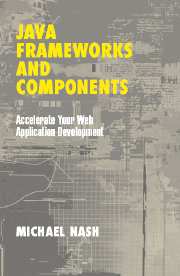Book contents
- Frontmatter
- Contents
- Acknowledgments
- 1 Components and Application Frameworks
- 2 Components: The Future of Web-Application Development
- 3 Application Frameworks: What Do They Provide and What Are the Benefits?
- 4 Choosing an Application Framework
- 5 A Catalog of Application Frameworks
- 6 Comparing Frameworks
- 7 Open Source and Components/Frameworks
- 8 Development Methodologies and Design Patterns
- 9 Integrated Development Environments
- 10 Strategies for Using Frameworks: Best Practices
- 11 Conclusions: The Future of Frameworks and Components
- Appendix: Case Studies
- Glossary
- Index
11 - Conclusions: The Future of Frameworks and Components
Published online by Cambridge University Press: 28 July 2009
- Frontmatter
- Contents
- Acknowledgments
- 1 Components and Application Frameworks
- 2 Components: The Future of Web-Application Development
- 3 Application Frameworks: What Do They Provide and What Are the Benefits?
- 4 Choosing an Application Framework
- 5 A Catalog of Application Frameworks
- 6 Comparing Frameworks
- 7 Open Source and Components/Frameworks
- 8 Development Methodologies and Design Patterns
- 9 Integrated Development Environments
- 10 Strategies for Using Frameworks: Best Practices
- 11 Conclusions: The Future of Frameworks and Components
- Appendix: Case Studies
- Glossary
- Index
Summary
In this chapter we summarize the discussions in the previous chapters to highlight the most significant points and discuss the future of frameworks and components. We look briefly at the trends that are leading the way to the future of application development, and how frameworks and components fit in.
EMERGING FRAMEWORK/COMPONENT TECHNOLOGIES
Frameworks are gradually expanding their reach into other areas of Web-application development. Combined with Java's advances with new and extended standard libraries, it means future Web applications will use some exciting new technologies.
The fastest growing segment of the Web-application community is the area of mobile and wireless application. Although some frameworks already focus on this market segment (Roaming Media Framework and Java Micro Framework), others also provide services to both desktop and mobile clients, such as Cocoon with its advanced WML support.
New Interface Paradigms and Frameworks
We have already discussed in previous chapters the importance of Web applications having highly flexible user interfaces. With the wealth of new devices being connected to the Internet today, your application will be called on to interact with everything from devices with effectively no visual interface at all (such as appliances, and even the fridge) to mobile devices with a functional but limited interface (such as Web-enabled televisions, cell phones, pagers, and other wireless clients), all the way to devices with extremely rich interface capabilities, such as full-blown desktop browsers with scripting support.
Information
- Type
- Chapter
- Information
- Java Frameworks and ComponentsAccelerate Your Web Application Development, pp. 364 - 376Publisher: Cambridge University PressPrint publication year: 2003
